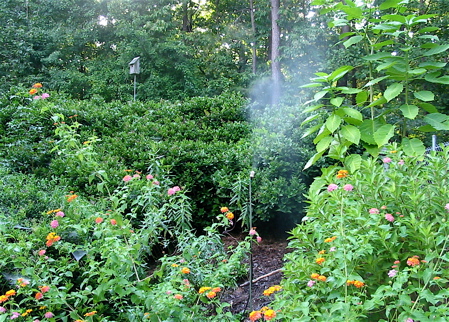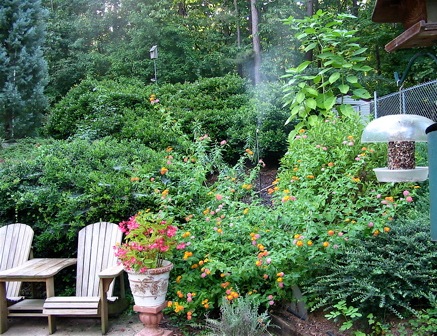-
use butterfly feeders along with leaf misters
Enticing butterflies has become a huge past-time for many gardeners and backyard birders alike. Earning nicknames like “flying flowers” and “winged jewels” these graceful beings bring joy and delight to many with their sheer presence. But what really works to bring butterflies to your place? There’s butterfly houses, and butterfly feeders, and butterfly baths, and puddlers too!
Although I’m no expert, during summer months you’ll find daily butterfly activity in our garden that’s pretty amazing. We have no butterfly house, nor do we use a feeder. The secret is a leaf mister and flowers which provide food in the form of nectar. Host plants are extremely important too – this is where butterflies lay their eggs. Host plants also provide a food source for the emerging caterpillar. Be forewarned though…heavy munching will occur on your host plants.
We see mostly Monarchs and Swallowtails, and Milkweed serves as the host plant. Lots of native shrubs and flowers entice butterflies and keep them around all season. Mature White Fringe Trees line the back yard, Service Berry shrubs sit in the front, Columbine, Trumpet Vine, Native Hibiscus, and Bottlebrush are just a few other plantings around the yard.
Butterflies do adore over-ripened fruit like bananas, oranges, melon and pears, but you must be sure the fruit does not mold. Butterfly puddlers are popular too, but it’s rare that they’ll drink from an open water source. Instead, the clay absorbs the water, and butterflies will sit upon the dampened clay surface. If using a but
terfly feeder, it should have a wick to absorb and draw up nectar from the basin, as butterflies will eat from the wick.
This season create a butterfly habitat by planting a few native species that will help them thrive and flourish. Add a leaf mister and you’ll see the increase in activity. If you build it… they will come!
Our summer butterfly habitat -
a very cool hanging bird bath indeed!
Although birds tend to bathe naturally at ground level, they usually flock to other fresh water sources too. A hanging bird bath is the perfect choice for smaller spaces, or yards where ground predators (cats) tend to lurk.
Fresh water in a bird bath is hands down, one of the best ways to entice more species to your place. If that fresh water happens to be moving… well, it’s like a visual magnet for wild birds! Accessories like water wigglers, leaf misters, and bird bath fountains will absolutely increase the activity around any bath. Hummingbirds for example, are extremely fond of bird bath fountains and bubblers. They can be seen playing and bathing in them on a daily basis if they’re already feeding in your yard.
Leaf misters are adored by butterflies and many songbirds too, including bluebirds. The misters are versatile, and may be attached to a plant stake, or a branch, or even a deck or porch with an over-hanging bracket. This hanging bird bath features a solar power mister that’s built right in. The valve is adjustable, so that on windier days a stronger flow or fountain may be used, as opposed to the gentle mist.
Moving water really does attract more birds! This season consider adding some type of water feature to your yard, then sit back and see the difference while helping wild birds thrive.
p.s. use code BB10 at checkout for 10% off any bird bath or bath accessories
good through April 30th 2011. -
Time to Dust Off those hummingbird feeders
The great hummingbird migration has begun!
Now is the time to get your hummingbird feeders out from storage and give them a good cleaning for the upcoming season. Plain hot water works, even if you send them through the dishwater, be sure to rinse them thoroughly to remove any residue. Along the Gulf of Mexico, Ruby Throats have started to claim territories, with other species following close behind.
Hummingbird season is an exciting one for many backyard birders, as these little sprites tend to provide some mesmerizing entertainment. Many folks could just sit and watch hummingbirds’ shenanigans for hours on end. Aside from the sugar water in hummingbird feeders, moving water is a very big attraction for them. Bathing, drinking and playing in birdbath fountains or bubblers comes naturally for hummers – they’re drawn to it like a magnet.
If you’re looking to attract more hummers, but already have enough hummingbird feeders, consider adding moving water to your landscape. Leaf misters for instance, are wildly popular among hummingbirds and butterflies as well. In the scolding heat of summer, the gentle mist is a most welcomed addition for many local wildlife species. Leaf misters may be installed in a variety of fashions. Ours stands upright in the garden twisted around a simple plant stake.
Treat your hummingbirds to a fun water feature this season and you’ll be rewarded by increased numbers and some fascinating activity and behaviors from the little guys!
Oh yeah… maybe this is the season to try making your own nectar too. It’s really quite simple and only takes a few minutes. Here’s the recipe: one part plain table sugar (cane) to four parts water. That’s it! Never use anything other than pure cane sugar (white table sugar) as it’s harmful to hummingbirds. There’s really no need to boil the water, we boil one cup simply to dissolve the sugar quicker and more effectively. If you do boil the water, be sure it has cooled before filling your hummingbird feeders. Store extra nectar in the fridge for up to two weeks. Now wasn’t that easy?






